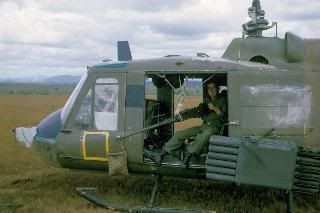Ray
Its interesting to me that with all the trials that were taking place in Rucker at the time, it was left to the crews already in Vietnam to adopt and augment an unsanctioned form of mount for the door gunners. I may be wrong but as far as i know it was a Japanese guy who invented the sagami. I would love to know more on the story, Was he in Vietnam, was he working for the US and if not why was it he and not the US military officials that responded to the needs of the helicopter crews under fire over in Vietnam. I may be completely wrong but for a Japanese sagami mount to arrive in Vietnam before the US M23 seems a bit strange to me.
I know that helicopter assault was in its infancy and alot of lessons were learnt in the field at the cost of many lives ( there is well documented reports of the new AH-1G cobras crashing in Vietnam without having time to send a distress call, it was later found that a fault in the helicopter was causing it to suddenly vear to the side, if it happened at high altitude it could be easily corrected by an experienced pilot but at low level it was proving fatal). (maybe some of the cobra experts out there can elaborate more on this for me).
I wonder sometimes if lessons will ever be learnt, will anyone ever listen to the troops in the field, did anyone ever see an official addition to the M60 to help stop the ammo belt flapping in the wind, that didnt come out of a C ration box!! Will it always take 42 years a hollywood movie and public interest to finaly get a medal of honour awarded to people like Bruce Crandall! Will there ever be enough flak jackets?
Moaning over. here's a diagram of mounts for the M60 & 50 cal that may be of some use.

If ever a picture showed a need for mounts in Vietnam i think its this one ![Big Smile [:D]](/emoticons/icon_smile_big.gif)

And another from B troop 1/9 Air Cav, showing Twin M60's on a sagami mount developed in the field by an inventive crew chief out of scrap parts (with a bit of scratch building i am hoping to turn my Academy heavy hog into this bird, will post pictures of progress when i start)

Some nice pictures there Ray.
Thanks
Andy
While the rest of the crew may be in the same predicament, it's almost always the pilot's job to arrive at the crash site first.